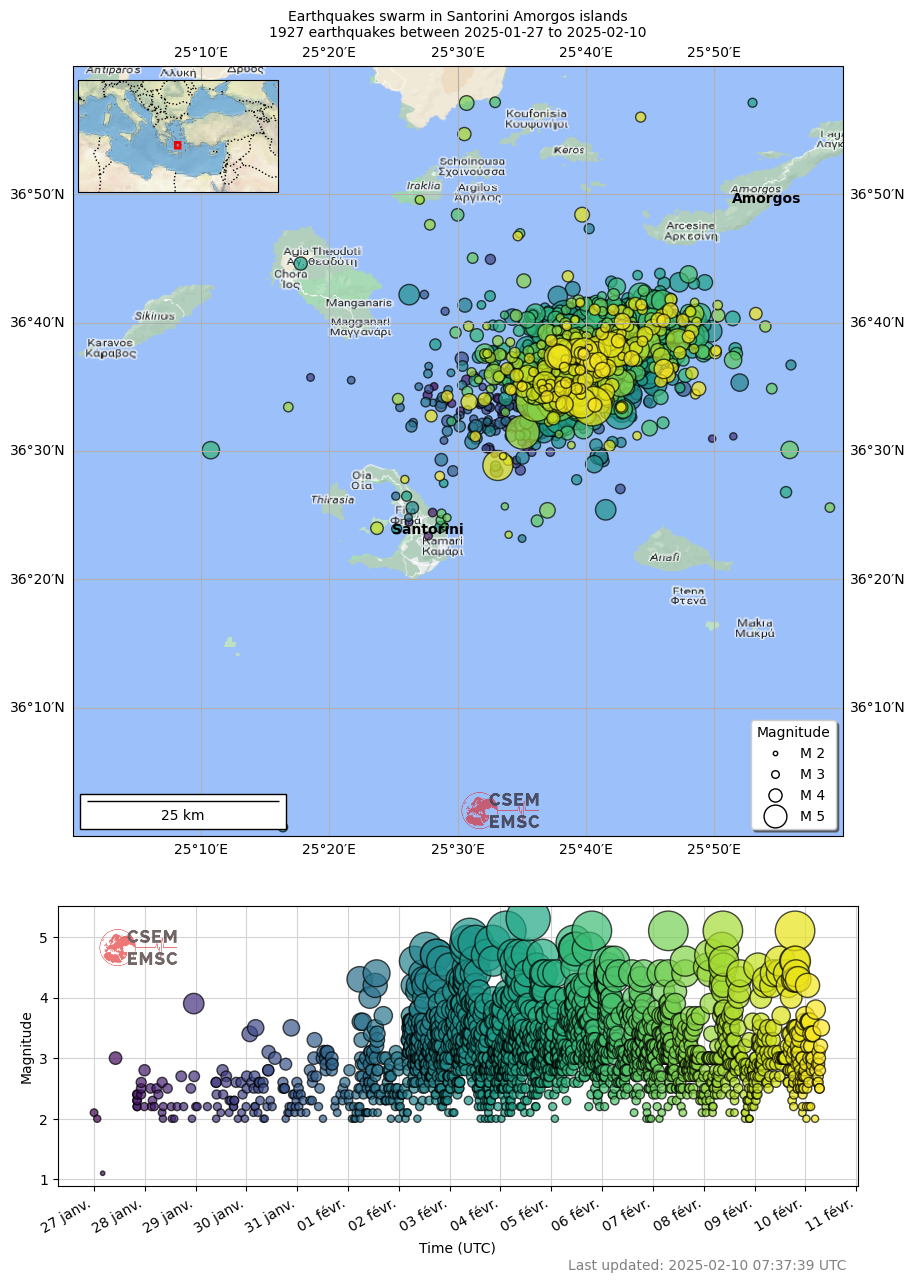State of Emergency and Uncertainty Amid Santorini Earthquake Swarm
Although the series of earthquakes on the island of Santorini is not linked to the activity of the Santorini volcano, researchers from the HUN-REN Institute of Earth Physics and Space Science note that it cannot yet be ruled out with absolute certainty. They have summarised the possible geological causes behind the events that may influence developments, and what to expect in the coming weeks.
In recent weeks, Santorini and its surrounding area have experienced intense seismic activity, significantly impacting the local population and infrastructure. As a result, the events have attracted worldwide attention. Authorities have implemented emergency measures, while experts continue to investigate the causes and potential consequences of the earthquakes. Residents are anxiously following developments unfold, while the region’s tourism industry has also suffered a severe blow.
More than 20,000 earthquakes in just a few weeks
Since 27 January, more than 20,000 earthquakes have been recorded in the region, with the strongest reaching a magnitude of 5.2. The epicentres are mainly located north-east of Santorini and south-west of Amorgos, approximately 25 kilometres apart. In recent days, authorities have been closely monitoring the situation, as the increasing frequency and intensity of the tremors pose significant challenges to both the local population and infrastructure. Although earthquake activity has now decreased in frequency and intensity, it could continue for months, and the possibility of a major earthquake cannot be ruled out.

State of emergency declared to protect residents
A state of emergency has been declared on Santorini due to ongoing seismic activity and is expected to remain in effect until 1 March. Schools have been closed, and authorities are advising residents to avoid coastal areas due to the risk of landslides and a potential tsunami. Two-thirds of the island’s 16,000 inhabitants have already left their homes, with many seeking refuge on the Greek mainland. In addition to the Greek government, the European Union has offered assistance, and some aid organisations have already begun supporting those displaced. Several neighbouring countries, including Italy and Turkey, have offered to send rescue teams to the region if needed.
What is behind the earthquakes?
It is entirely reasonable for society to expect reliable and accurate information from researchers. Such information is always based on observations—mostly in real time—provided by monitoring networks that supply geophysical, geodetic, and geochemical data. The current situation underscores the immense importance and societal impact of continuous monitoring of geological hazards. In recent weeks, reports on earthquakes in the Aegean Sea have relied almost exclusively on seismological data. However, a comprehensive understanding of geological events requires a much broader range of observations.
According to current knowledge, the earthquakes are primarily caused by the movement of tectonic plates in the region. Greece lies at the junction of the African and Eurasian tectonic plates, whose movements frequently trigger earthquakes. While it is unlikely that the current swarm of quakes is linked to Santorini’s volcanic activity, this cannot yet be ruled out with absolute certainty, making further monitoring necessary.
An earthquake swarm is a sequence of seismic events in which multiple small to large earthquakes occur within a short period, without a single major mainshock being identifiable. The epicentres of the recent tremors differ from previously known magma reservoir locations, suggesting they are unlikely to be direct precursors to an imminent volcanic eruption.
To understand geological processes in a given area, it is essential to have a monitoring network with sufficient spatial coverage and a sufficiently long observation period. Based on this, it is important for each country to have a network tailored to its local geological conditions in order to provide decision-makers and the public with adequate information and forecasts on geological hazards. In Hungary, one of the key institutions in this field is the HUN-REN Institute of Earth Physics and Space Science, which collaborates with national authorities, universities, and research institutions.
At present, the following is known and speculated regarding the earthquakes occurring to the north-east of Santorini:
- A special series of earthquakes is occurring, with the intensity and frequency of the tremors decreasing slightly over time. This phenomenon is generally referred to as an earthquake swarm.
- Earthquakes are not considered unusual in the region and are primarily related to the tensional stress associated with the subduction of the Aegean Plate. As a result, earthquakes in the affected area are linked to normal faults that strike west-southwest to east-northeast and dip south-southeast, associated with the Amorgos and Santorini-Amorgos structural lines.
- Earthquake swarms are often associated with the flow of fluids and melts towards the surface. However, in most cases, these do not reach the surface and do not lead to volcanic eruptions. It is important to note that the epicentres of the current tremors differ from previously known magma reservoir locations.
- Based on current observations, past experience, and the information available to researchers in Hungary, the most likely scenario is that the earthquake swarm will eventually subside. While less likely, it cannot be entirely ruled out that these tremors are foreshocks of a larger earthquake or even precursors to a volcanic eruption.
"If new information becomes available in the future, either from databases or from updates provided by local colleagues, we will inform the public," added the researchers at HUN-REN EPSS.
Historical seismic events in Santorini
Throughout its history, Santorini has experienced several devastating earthquakes and volcanic eruptions. One of the most significant events occurred around 1600 BC, when a massive volcanic eruption destroyed much of the island. On 9 July 1956, a magnitude 7.5 earthquake struck the region, causing severe destruction on both Amorgos and Santorini. The earthquake also triggered a tsunami that reached Crete and other nearby islands.
What to expect in the coming weeks?
The most likely scenario is that the earthquakes will subside over time. However, experts cannot rule out the possibility of a major seismic event or even volcanic activity. Authorities and researchers are constantly monitoring the situation and updating their forecasts as new information becomes available.

